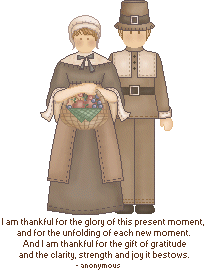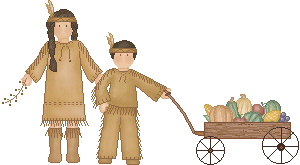Thanksgiving
History and Traditions
 During
the American Revolution (late 1770's) a day of national thanksgiving
held after the harvest was suggested by the Continental Congress.
In 1817
New York State had adopted Thanksgiving Day as an annual custom.
By the middle of the 19th century many other states also celebrated
a Thanksgiving Day. In 1863 President Abraham Lincoln appointed
a national day of thanksgiving. Since then each president has
issued a Thanksgiving Day proclamation, usually designating the
fourth Thursday of each November as the holiday.
Thanksgiving
was first celebrated by Pilgrims and Native Americans in colonial
New England in the early 17th century. Its actual origin, however,
probably traces to harvest festivals that have been traditional
in many parts of the world since ancient times. Today Thanksgiving
is mainly a celebration of domestic life, centered on the home
and family.
In
the United States, Thanksgiving is also the start of the Christmas
shopping season. Aside from the idea of celebrating a plentiful
harvest, gathering the family and preparing a large meal, people
also celebrate Thanksgiving Day with parades, which often feature
children and adults dressed in Pilgrim costumes.
The
Thanksgiving Day Parades, probably got their start when President
Lincoln proclaimed an official day of Thanksgiving. Any official
event declared by the President would have been accompanied by
a show of military strength and discipline such as a full-dress
parade. Today, elaborate floats, musical shows and entertainment
celebrities have replaced the parades of armed and uniformed
men.
Many
of the images associated with Thanksgiving derive from old traditions
of celebrating harvest. The cornucopia, a horn-shaped basket
filled with fruits and vegetables, is a typical symbol of Thanksgiving
abundance that dates to ancient harvest festivals. Many communities
also decorate their churches with fruits, flowers, and vegetables
at Thanksgiving, such as European communities have done for centuries
during the autumn harvest season.
The
key to a Thanksgiving menu is to choose foods that will represent
the idea of giving thanks for a good year, a harvesting of good
fortune, and the sharing of the bounty of your efforts with friends
and family.
Today,
Thanksgiving menus usually include turkey, bread-crumb stuffing,
cranberry sauce, squash, mashed potatoes, sweet potatoes, and
pumpkin pie. Though there is no real evidence that turkey was
served at the Pilgrim's first thanksgiving, in a book written
by the Pilgrim's Governor Bradford he does make mention of wild
turkeys. In a letter sent to England, another Pilgrim describes
how the governor sent "four men out fowling" returning
with turkeys, ducks and geese. While it is possible that turkeys
may have been killed, it is more likely that ducks or geese were
the primary targets. Tough, resourceful, able to fly and hard
to catch, turkeys were not the first choice of either Native
Americans or early colonial hunters.
During
the American Revolution (late 1770's) a day of national thanksgiving
held after the harvest was suggested by the Continental Congress.
In 1817
New York State had adopted Thanksgiving Day as an annual custom.
By the middle of the 19th century many other states also celebrated
a Thanksgiving Day. In 1863 President Abraham Lincoln appointed
a national day of thanksgiving. Since then each president has
issued a Thanksgiving Day proclamation, usually designating the
fourth Thursday of each November as the holiday.
Thanksgiving
was first celebrated by Pilgrims and Native Americans in colonial
New England in the early 17th century. Its actual origin, however,
probably traces to harvest festivals that have been traditional
in many parts of the world since ancient times. Today Thanksgiving
is mainly a celebration of domestic life, centered on the home
and family.
In
the United States, Thanksgiving is also the start of the Christmas
shopping season. Aside from the idea of celebrating a plentiful
harvest, gathering the family and preparing a large meal, people
also celebrate Thanksgiving Day with parades, which often feature
children and adults dressed in Pilgrim costumes.
The
Thanksgiving Day Parades, probably got their start when President
Lincoln proclaimed an official day of Thanksgiving. Any official
event declared by the President would have been accompanied by
a show of military strength and discipline such as a full-dress
parade. Today, elaborate floats, musical shows and entertainment
celebrities have replaced the parades of armed and uniformed
men.
Many
of the images associated with Thanksgiving derive from old traditions
of celebrating harvest. The cornucopia, a horn-shaped basket
filled with fruits and vegetables, is a typical symbol of Thanksgiving
abundance that dates to ancient harvest festivals. Many communities
also decorate their churches with fruits, flowers, and vegetables
at Thanksgiving, such as European communities have done for centuries
during the autumn harvest season.
The
key to a Thanksgiving menu is to choose foods that will represent
the idea of giving thanks for a good year, a harvesting of good
fortune, and the sharing of the bounty of your efforts with friends
and family.
Today,
Thanksgiving menus usually include turkey, bread-crumb stuffing,
cranberry sauce, squash, mashed potatoes, sweet potatoes, and
pumpkin pie. Though there is no real evidence that turkey was
served at the Pilgrim's first thanksgiving, in a book written
by the Pilgrim's Governor Bradford he does make mention of wild
turkeys. In a letter sent to England, another Pilgrim describes
how the governor sent "four men out fowling" returning
with turkeys, ducks and geese. While it is possible that turkeys
may have been killed, it is more likely that ducks or geese were
the primary targets. Tough, resourceful, able to fly and hard
to catch, turkeys were not the first choice of either Native
Americans or early colonial hunters.

|



